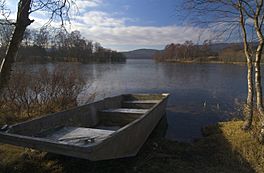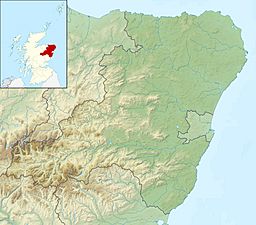Loch Kinord facts for kids
Quick facts for kids Loch Kinord |
|
|---|---|
| Loch Kinnord, Loch Ceander, Loch Cannor | |
 |
|
| Location | Aberdeenshire, Scotland |
| Coordinates | 57°4′54″N 2°55′22″W / 57.08167°N 2.92278°W |
| Type | freshwater loch |
| Primary inflows | Vat Burn |
| Primary outflows | River Dee |
| Basin countries | Scotland |
| Max. length | 1 mi (1.6 km) |
| Max. width | 0.25 mi (0.40 km) |
| Surface area | 76.9 ha (190 acres) |
| Average depth | 5 ft (1.5 m) |
| Max. depth | 12 ft (3.7 m) |
| Water volume | 41,000,000 cu ft (1,200,000 m3) |
| Shore length1 | 7.1 km (4.4 mi) |
| Surface elevation | 167 m (548 ft) |
| Islands | 7 |
| 1 Shore length is not a well-defined measure. | |
Loch Kinord is a beautiful, small freshwater lake, known as a loch in Scotland. You can find it in Aberdeenshire, near the River Dee. It's about 1 mi (1.6 km) long.
This loch was formed a long time ago by a glacier. It sits inside the Muir of Dinnet National Nature Reserve, which is a special protected area for nature. Loch Kinord has several small islets (tiny islands) and is surrounded by birch trees. It is sometimes called Loch Ceander or Loch Cannor.
Contents
Discovering Loch Kinord's Wildlife
Loch Kinord is quite shallow, which means sunlight can reach the bottom. This helps many different water plants grow there.
Plants of the Loch
You can find plants like water lobelia, quillwort, and shoreweed growing in the loch. In the summer, pretty white water lilies float on the surface. Around the edges of the loch, you'll see reeds, sedges, horsetails, and bulrushes. There's also a forest of European beech trees nearby.
Animals Living in and Around the Loch
The loch is home to many animals. You might spot pike swimming in the water. Otters also live here, hunting for food. For bird watchers, there are goldeneyes, migrating geese, and other types of wildfowl (water birds).
Loch Kinord's Ancient History
Loch Kinord has a long and interesting history, with signs of people living here thousands of years ago.
Iron Age Crannogs
Long ago, during the Iron Age, people built special island homes called crannogs in the loch. These were probably used for protection. They would drive strong oak tree trunks into the loch bed and then build up stones around them. On top of this structure, they would build a hut. You can still see one of these old crannogs today as a small island covered with trees.
The Pictish Stone
On the north shore of the loch, there's a very old Pictish stone from the 9th century. The Picts were an ancient people of Scotland. This stone is carved with amazing patterns and knot work. It suggests that there might have been a small monastery or chapel nearby a long time ago. The stone was lost and buried for many years but was found again in the 1820s. It was moved to Aboyne Castle for a while, but in 1959, it was brought back to its original spot by the loch.
Roman Times and a Medieval Castle
Even when the Romans were in Britain (from about 80 to 399 CE), a fort was built on a southern point of the loch. This was built because people heard rumors that the Romans might invade. Later, a castle stood on one of the loch's small islands. The first time this castle was written about was in 1335. It was used as a safe place for the Earl of Atholl after a battle called the Battle of Culblean.
Archaeologists have also found other old items at the loch, including a bronze jug from the Middle Ages.
Fun Activities at Loch Kinord
Loch Kinord is a great place to visit and enjoy nature.
Walking and Wildlife Spotting
There's a walking path that goes all the way around the loch. It's a perfect way to see the beautiful scenery and look for birds and other wildlife. The walk usually starts from the Burn O'Vat car park, which is on the road between Ballater and Aboyne.
Running Events
Since 2009, the Kinord Hall Committee has organized a 10-kilometer (about 6.2 miles) running race around the loch. The very first race took place on October 24, 2009.
Images for kids



